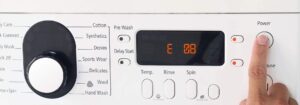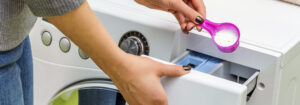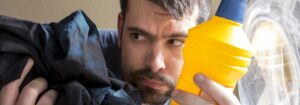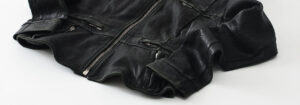Front-loading washing machines typically have a rubber gasket or seal around the front door for an important reason. The function of the rubber gasket is to create a watertight seal when the door is closed. Front-loading machines use a horizontal drum that rotates on a horizontal axis, and this design requires a secure seal to prevent water from leaking during the washing and spinning cycles.
Why does mould grow on the rubber gasket
Mould can grow on the rubber gasket of a front-loading washing machine due to a combination of factors, including moisture, warmth, and the presence of organic materials (such as detergent residues and lint). Front-loading machines seal tightly during operation to prevent water leakage. However, this also means that moisture can become trapped in the rubber gasket, especially in the folds and crevices, creating an environment favourable for mould growth.
Rubber, especially natural rubber, can have microscopic pores and crevices on its surface. These pores create a textured environment where mould spores can settle and find shelter.
Mould can embed itself into the pores of rubber, making it more challenging to clean thoroughly. Even if you clean the surface, mould spores deep within the pores may remain, potentially leading to recurring mould issues.
How to get mould off a washing machine’s rubber seal
Removing mould from the rubber seal on a washing machine can be relatively straightforward with the right cleaning materials and methods.
Materials:
- White vinegar
- Baking soda
- Soft toothbrush
- Sponge
Here’s a step-by-step guide to help you clean mould from the rubber gasket of your front-loading washing machine:
Step 1: Mix equal parts white vinegar and water in a bowl. Alternatively, you can make a paste by mixing baking soda with a small amount of water.
Step 2: Dampen a microfiber cloth or sponge with the cleaning solution and wipe away visible mould on the rubber gasket. Focus on the areas with mould growth.
Step 3: Apply the cleaning solution (vinegar and water mix) directly to the affected areas. If using a baking soda paste, spread it over the mouldy spots.
Step 4: Use a soft brush or toothbrush to scrub the rubber gasket. Pay extra attention to the folds and crevices where mould tends to hide.
Step 5: Allow the cleaning solution to sit on the rubber gasket for at least 15 minutes.
Step 6: Scrub the rubber gasket once again, focusing on any stubborn mould spots.
Step 7: Rinse the rubber gasket thoroughly with water to remove the cleaning solution and any remaining mould residues.
Step 8: Wipe the rubber gasket dry with a clean, dry cloth. Leave the washing machine door open for a while to allow the gasket to air dry completely.
To prevent future mould growth, make it a habit to leave the washing machine door ajar between uses to promote airflow and dry out the gasket.
If you regularly clean the rubber seal and address mould at the first sign, it is generally easier to remove. Frequent cleaning helps prevent mould from establishing deep roots, making removal more manageable.








